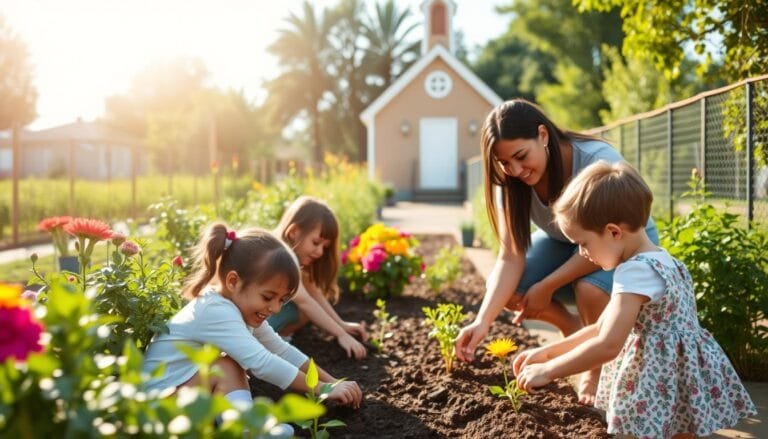Catholic Children’s Liturgy
This website contains affiliate links. As an Amazon Associate, I earn from qualifying purchases. The content on this website was created with the help of AI.
A whopping 95% of kids in regular Children’s Liturgy feel closer to their faith. This shows the big impact of Catholic children’s Mass on young believers.
Let’s dive into how this special approach shapes kids’ spiritual lives.
Children’s Liturgy is for kids aged 4-11. It helps them grow in faith by making Mass just right for them. This method isn’t just busy work; it’s a powerful way to nurture young Catholics.
More U.S. parishes are seeing the value of kid-focused worship. They use fun activities, pictures, and simple words to bring the Gospel to life.
This gets kids excited about their faith journey early on.
Key Takeaways
- Children’s Liturgy targets kids aged 4-11
- 95% of participants feel more connected to their faith
- Includes adapted prayers, readings, and activities
- Enhances understanding of Mass for young believers
- Fosters active participation in religious education
- Utilizes interactive elements and visual aids
- Nurtures spiritual growth in children and communities
Understanding Catholic Children’s Liturgy
Catholic children’s liturgy is crucial for young believers’ spiritual growth. It provides a tailored worship experience for kids.
This approach helps nurture faith from childhood through engaging activities.
Definition and Purpose
Children’s Liturgy of the Word (CLOW) is a special Mass celebration for young Catholics. It targets kids aged 5-8 who haven’t completed sacramental initiation.
CLOW aims to make Catholic teachings easy for children to understand.
Biblical Foundation for Children’s Worship
Jesus’ words, “Let the little children come to me,” inspire children’s worship. The Catholic Church creates a welcoming space for kids.
Here, young minds can connect with God’s word in their own way.
Role in Faith Formation
Children’s liturgy is essential for developing strong faith. It adds to formal religious education with hands-on experiences. Age-appropriate methods help kids build a solid spiritual foundation.
The Order of Baptism of Children guides our approach to children’s liturgy. The Directory for Masses with Children also provides valuable input.
These documents stress the need for flexibility in different settings.
We focus on meeting children’s unique spiritual needs. This approach helps foster a deep connection with their faith. Starting early can lead to lifelong spiritual growth.
Essential Components of Children’s Mass
Children’s Mass engages young minds in worship. We create a welcoming space for kids to explore faith. Interactive worship and child-friendly Gospel readings are our focus.
Opening Prayer and Gospel Reading
Our Children’s Liturgy starts with a simple opening prayer. We then share the Gospel in kid-friendly language. This helps children connect with sacred Scripture meaningfully.
Child-friendly Homily Techniques
We use storytelling, visual aids, and questions to make the Gospel message stick. These methods bring teachings to life. They make the message relatable to children’s everyday experiences.
Interactive Prayer Activities
Hands-on activities keep children engaged during prayer time. We might create prayer cards or act out Bible stories. Sharing intentions is another way to make prayer personal.
Music and Movement in Worship
Catholic hymns are crucial in our children’s liturgy. We choose upbeat, easy-to-learn songs that reinforce the day’s message. Adding simple movements helps kids express their joy physically.
These elements create a vibrant, age-appropriate liturgy for young Catholics. Our goal is to make Mass a joyful learning experience. We want children to look forward to attending each week.
Creating an Engaging Liturgical Experience
Catholic worship can be exciting for kids. Our goal is to spark their interest in faith. We’ll explore effective ways to create an interactive Catholic education.

Age-appropriate Teaching Methods
Faith activities should match children’s understanding levels. Sojourn Community Church—Midtown uses month-long teaching units.
They repeat songs, scriptures, and catechism questions weekly.
This approach helps kids grasp concepts better. It’s a great way to make learning stick!
Visual Aids and Props
Pictures and props make abstract ideas concrete for young minds. Hand motions help teach memory verses. Kids find it easier to remember Scripture this way.
Incorporating Sacred Scripture
Scripture for kids should be engaging and memorable. Call-and-response methods can teach Bible verses effectively. Songs that echo Scripture help too.
It’s about making God’s Word accessible and exciting for little ones.
Building Community Through Participation
Community building happens when kids actively join in. We can use familiar songs from adult services. Adjust them for young voices.
Start with choruses before verses to help quick learning. Simple songs with deep truths help children connect with God best.
“Make worship accessible to children by choosing songs that are simple yet convey profound truths to help children engage with God.”
These aspects create a vibrant liturgical experience for young Catholics. It nurtures their faith in fun, meaningful ways!
Preparing Leaders for Children’s Ministry
Our Catholic ministry training equips children’s liturgy leaders for effective faith education. We focus on nurturing young Catholics through engaging liturgy.
Our goal is to create future faithful Catholics.

Our program covers key aspects of children’s liturgy. Leaders learn to select age-appropriate scriptures and create engaging homilies.
We aim to foster an environment where children can grow in faith.
Our comprehensive training includes child development, liturgical practices, and effective communication.
We also teach interactive methods to enhance learning. These skills help leaders guide young minds effectively.
Children’s liturgy leaders learn to make each session unique. They highlight feast days, baptisms, and church seasons. Visual aids and activities reinforce Gospel themes.
Our Children’s Liturgy of the Word is both educational and engaging. Kids sign in, hear sacred stories, and share prayers. This format helps children connect personally with their faith.
Like teaching the Ten Commandments, our approach makes faith accessible to young minds. We prepare leaders to guide children’s spiritual growth. Our aim is to foster a lifelong love for liturgy.
Conclusion
Catholic Children’s Liturgy plays a vital role in youth engagement across U.S. parishes. It significantly shapes Catholic faith formation and spiritual growth.
The Children’s Liturgy of the Word helps young believers connect with their faith more easily.
About 62% of parishes offer separate Liturgies for children. This shows how widely accepted this practice has become. Children’s liturgy offers many benefits for young minds.
It encourages active participation and deepens understanding of the Mass. Kids can explore their faith, pray, and reflect on God’s word in an age-appropriate way.
However, challenges exist. The wide age range of participants can be tricky to manage. Some worry about family unity during Mass.
Moving forward, we need to balance children’s liturgy with family worship. This will help keep Catholic faith formation strong.
It will nurture a new generation of spiritually grounded individuals.













